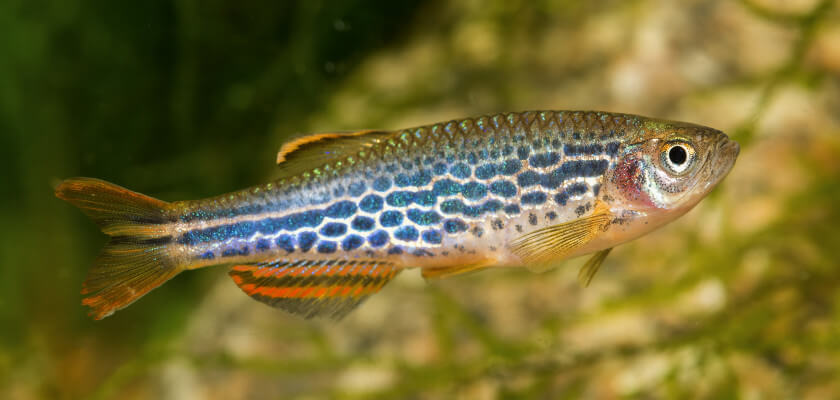Danio are a very popular species when it comes to Polish aquariums. Most of them, apart from zebrafish, are species that occur naturally in Asian countries. Danio found in Colombia has been imported there and is considered an invasive species. Is it difficult to breed zebrafish at home? What are the requirements of zebrafish? Check!
Danio – species
The zebrafish come in various species and color varieties. Here are the most common.
Rainbow Danio
Rainbow Danio is a fish that naturally lives in Southeast Asia, mainly in the area of Thailand. It grows up to about 6 cm in captivity. The name of this fish comes from the specific color which gives the fish a pearly glow. Its color scheme is actually greenish-purple. This species of zebrafish requires a large reservoir and feels best in a herd.
Danio Malabarski
These zebrafish grow up to 10 cm in length, so they are significantly larger than the rest of their cousins. They are suitable for multi-species tanks where they feel good as long as they stay in a herd with other zebrafish. It requires a large tank, also due to its large size.
Danio lamparcie
As the name suggests, the leopard zebra has a distinctive appearance. They have a brown color with a golden sheen, and are additionally covered with black dots and sometimes even stripes. Currently, scientists are of the opinion that this is a variety of zebrafish, although this is not entirely certain position. This zebrafish grows up to 5 cm in length. It is a predatory, herd fish. With a larger shoal, it needs an adequately large aquarium.
Danio pręgowane
Their system name is Denmark rerio. These zebrafish aquarium fish are the most popular. They grow up to 5 cm and are also available in two varieties:
- with standard fins;
- with elongated, veil-like fins.
These fish are brownish-golden in color with black, longitudinal stripes running throughout the body. It is a typical herd fish that swims quickly and prefers the company of representatives of the same species.
Neon Danio
The ethics of zebrafish breeding is still controversial. Many aquarists believe that this fish suffers when it is of a non-standard color. Meanwhile, according to scientific studies, color is innate and not injected, as some believe. In this regard, some simply consider such danios as a colorful species variety.
Neon Danio is available in many versions, including:
- danio fluo;
- zebrafish pink;
- zebrafish red.
Yellow or pink aquarium fish arouse a lot of enthusiasm among beginners and avid aquarists. However, remember that such varieties of zebrafish are considered genetically modified organisms. Therefore, for their breeding, and the possession itself, you must have the appropriate permits throughout the European Union. As a result, neon lights are often sold illegally – it is not worth lingering to such a practice.
Danio – optimal conditions
Danio are fish that live mainly in single-species herds. They can also form shoals with other zebrafish. The minimum size of the shoal is 8 individuals. Danio should not be combined with fish that are aggressive or very slow. The mobility of these fish means that they can simply be a nuisance to such species.
Aquarium for zebrafish
The minimum size of the aquarium for zebrafish is 60 cm of the length of the glass. At the same time, Malabar’s danios are an exception, for which the minimum length of the tank is 100 cm. All because they grow up to twice the size of other species.
The aquarium should be equipped with a lid to prevent the fish from jumping out. Dense cultivation of plants will work, especially tall plants planted in the last plan. The type of substrate is technically irrelevant. However, dark gravel or sand make the color of the fish more visible. The aquarium should have an efficient filter, a sprinkler and a heater, if necessary.
Requirements of zebrafish
Danio requires water at a minimum temperature of 20 ° C. At the same time, the pH should be slightly acidic. Water changes should be performed approximately every two weeks, but even by 30%.
Danio – caring for the fish
Like all aquarium fish, zebrafish require proper care. Here are the basics.
Danio – reproduction
Under artificial conditions, the zebrafish population can be increased. Propagated for the most common species is not especially complicated. The start of spawning is promoted by abundant feeding with live food. Danio has no clearly marked sex characteristics until the zebrafish is pregnant. Then her belly becomes round.
The female is able to lay up to a thousand eggs during one spawning. The zebrafish usually sinks to the bottom and swims freely because it does not stick to any surfaces. If the aquarium is properly managed and there is no shortage of vegetation in it, the zebrafish are able to develop without being caught. Otherwise, it is a good idea to catch the roe in a separate aquarium.
Feeding the zebrafish
Feeding zebrafish is also not particularly complicated. This fish is omnivorous. He eats both artificial and natural food. Both live, properly disinfected and frozen food are suitable for its nourishment. Danio, however, also eats various granules and flakes.
It is worth feeding zebrafish several times a day, but with a small amount of food. In this way, the aquarium stays in good condition for longer. It is advisable to stop feeding for one day once a week. The fry, in turn, should receive specialized food, preferably in an easily digestible form. Also, be careful not to give too much of it at once.
Danio are small fish that are very popular among aquarists of various levels of advancement. It does great in multi-species tanks and is resistant to many diseases. With a well-prepared aquarium, it can reproduce without any additional treatments on your part. Check if the zebrafish will feel good in your aquarium!

